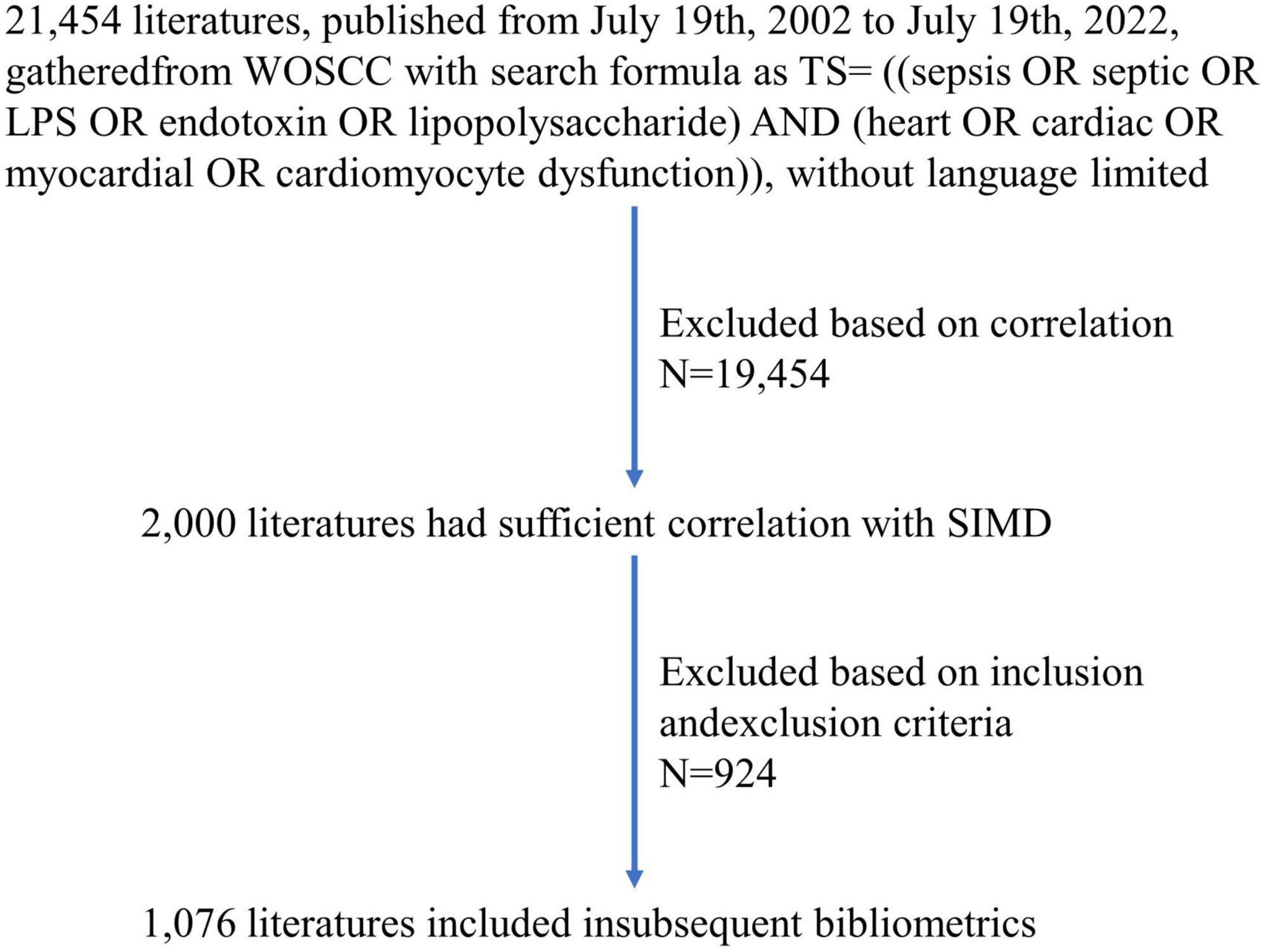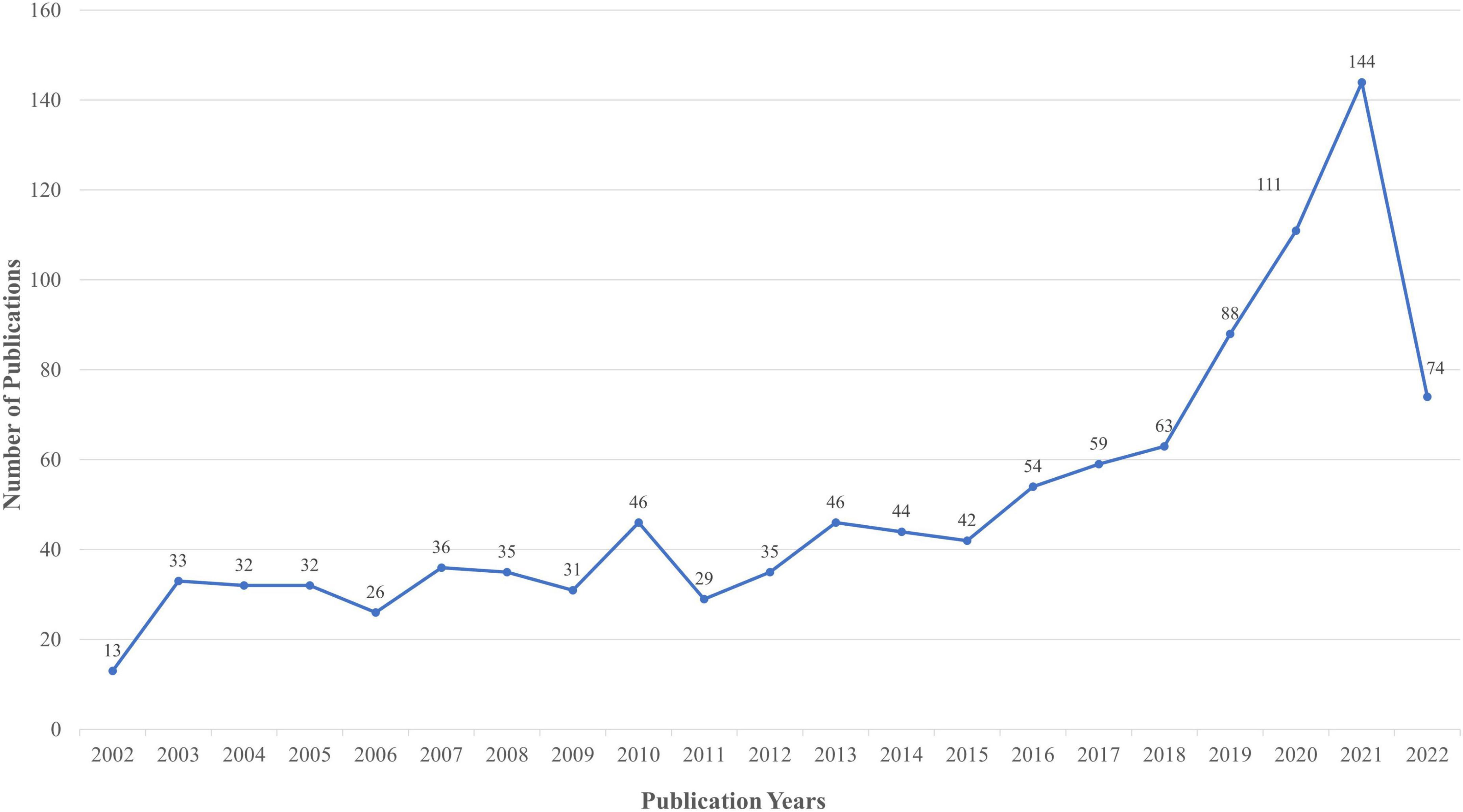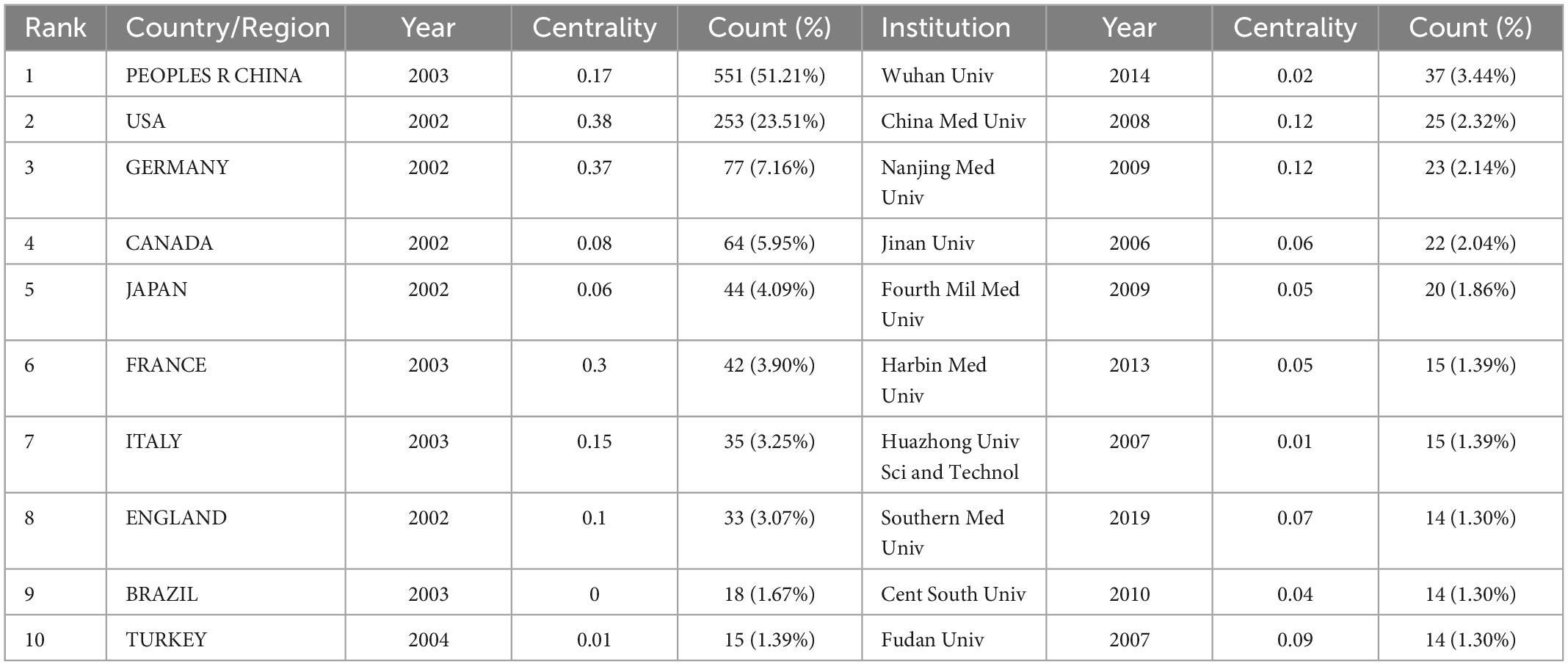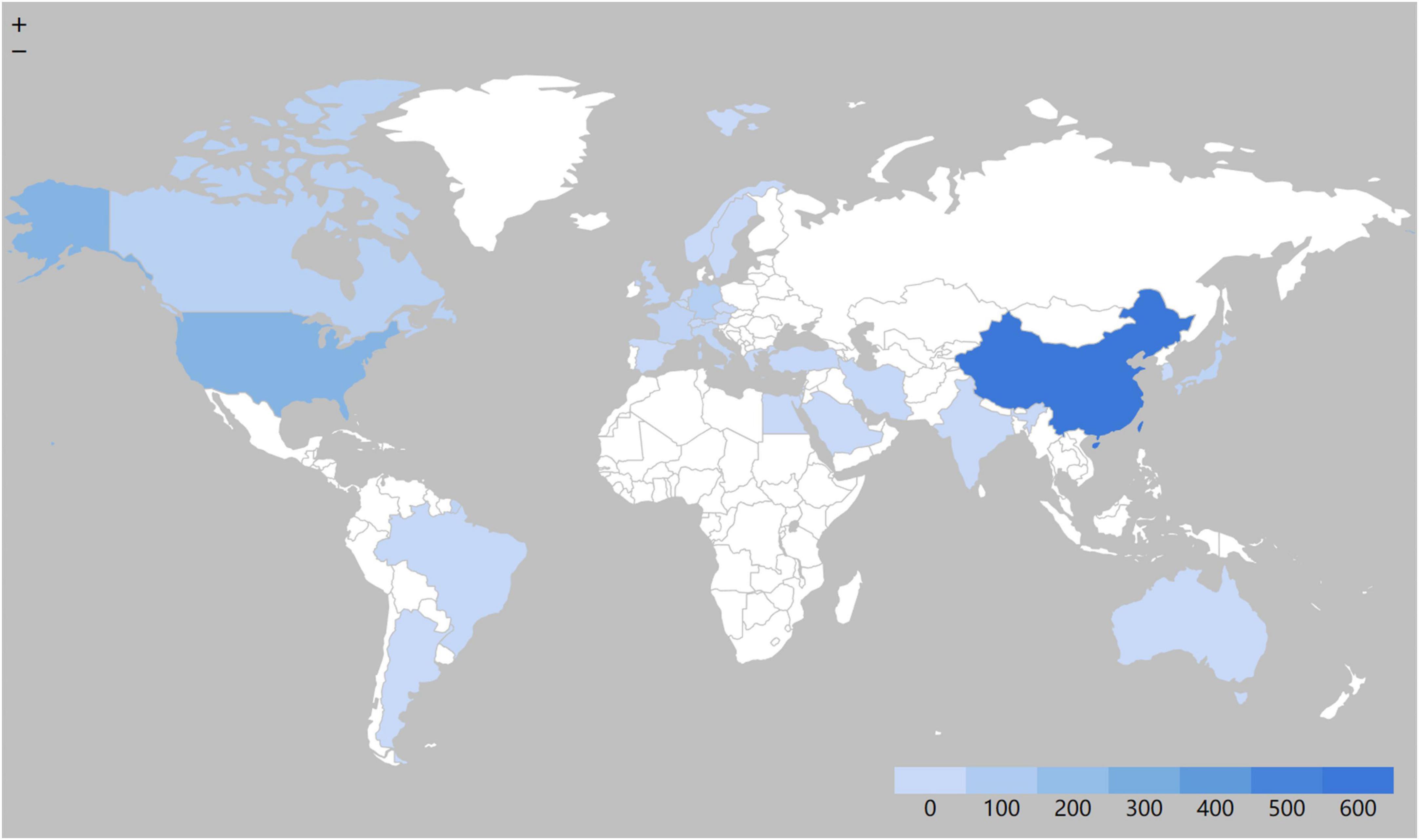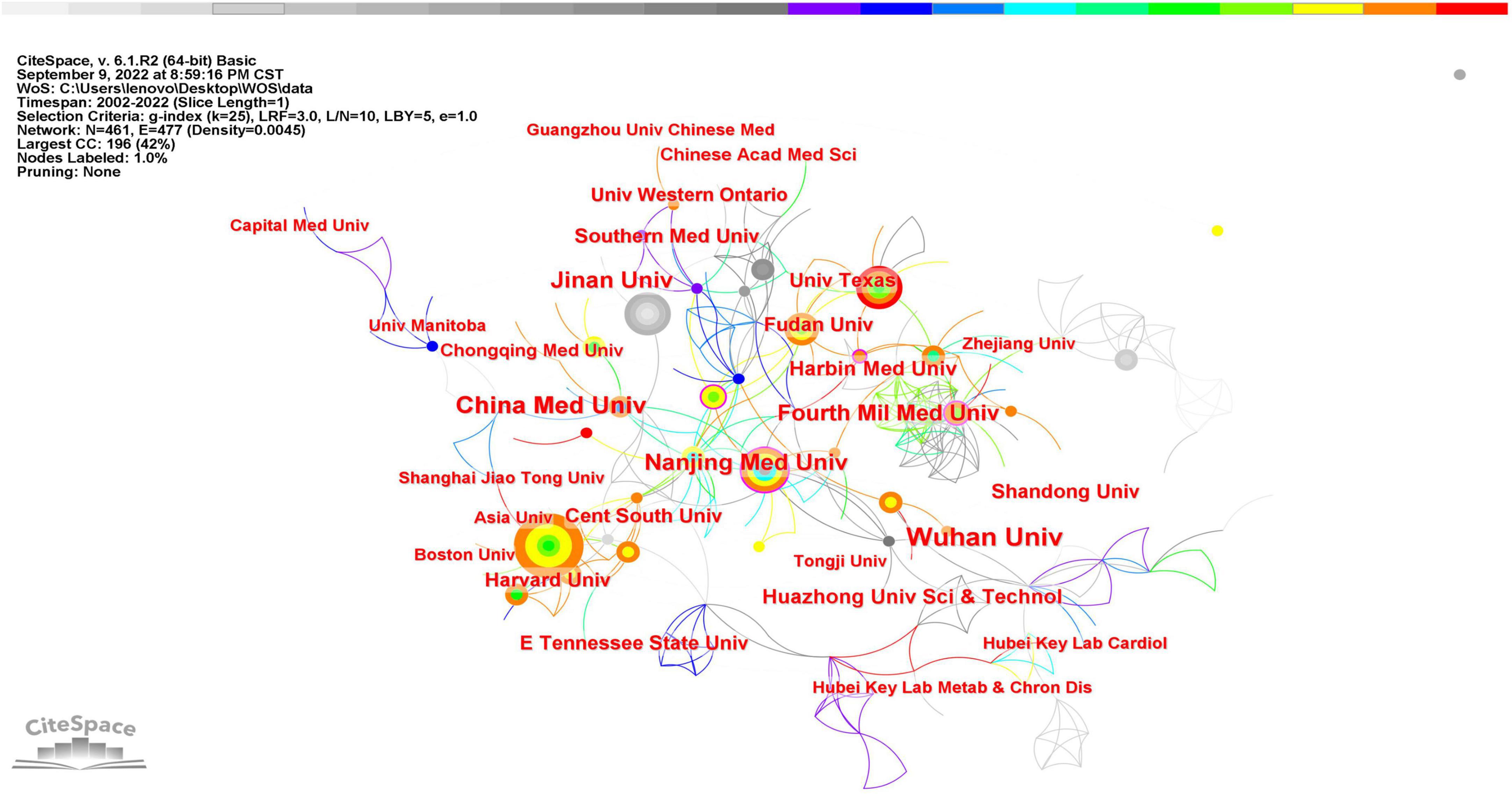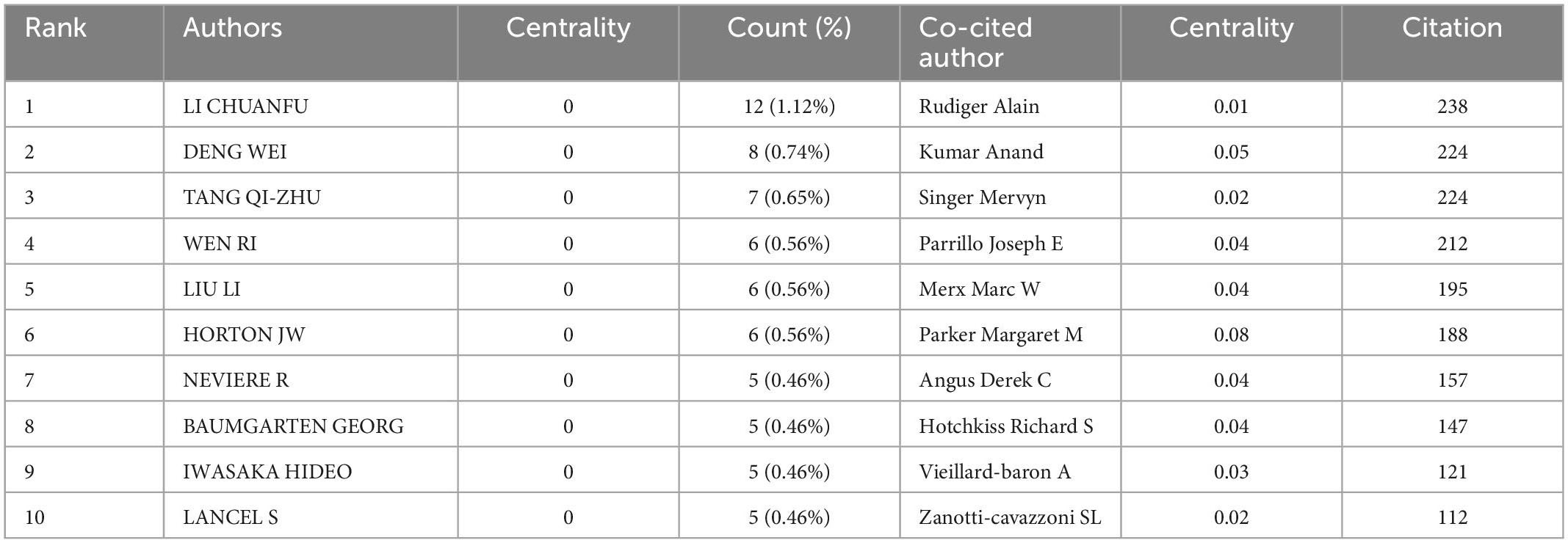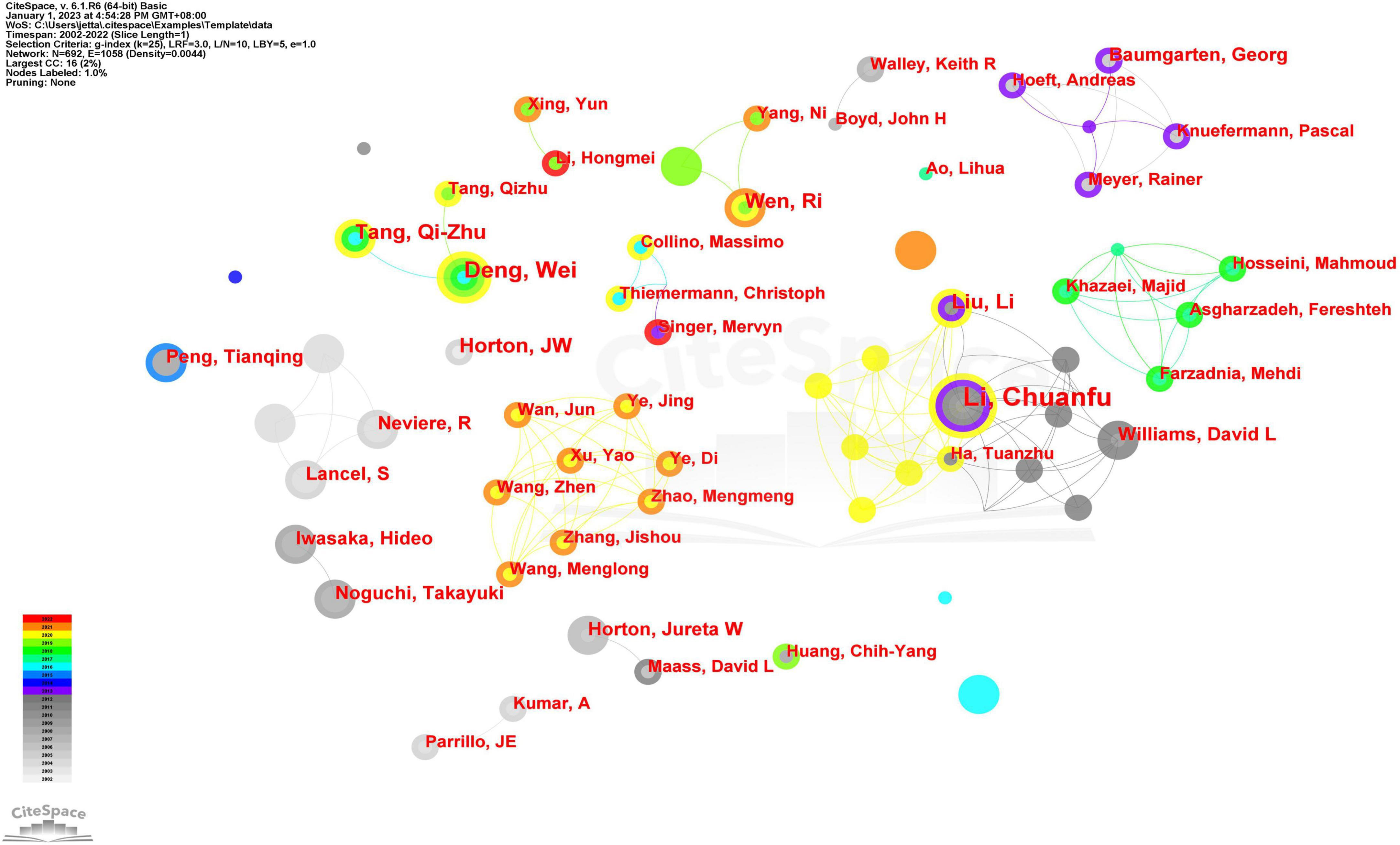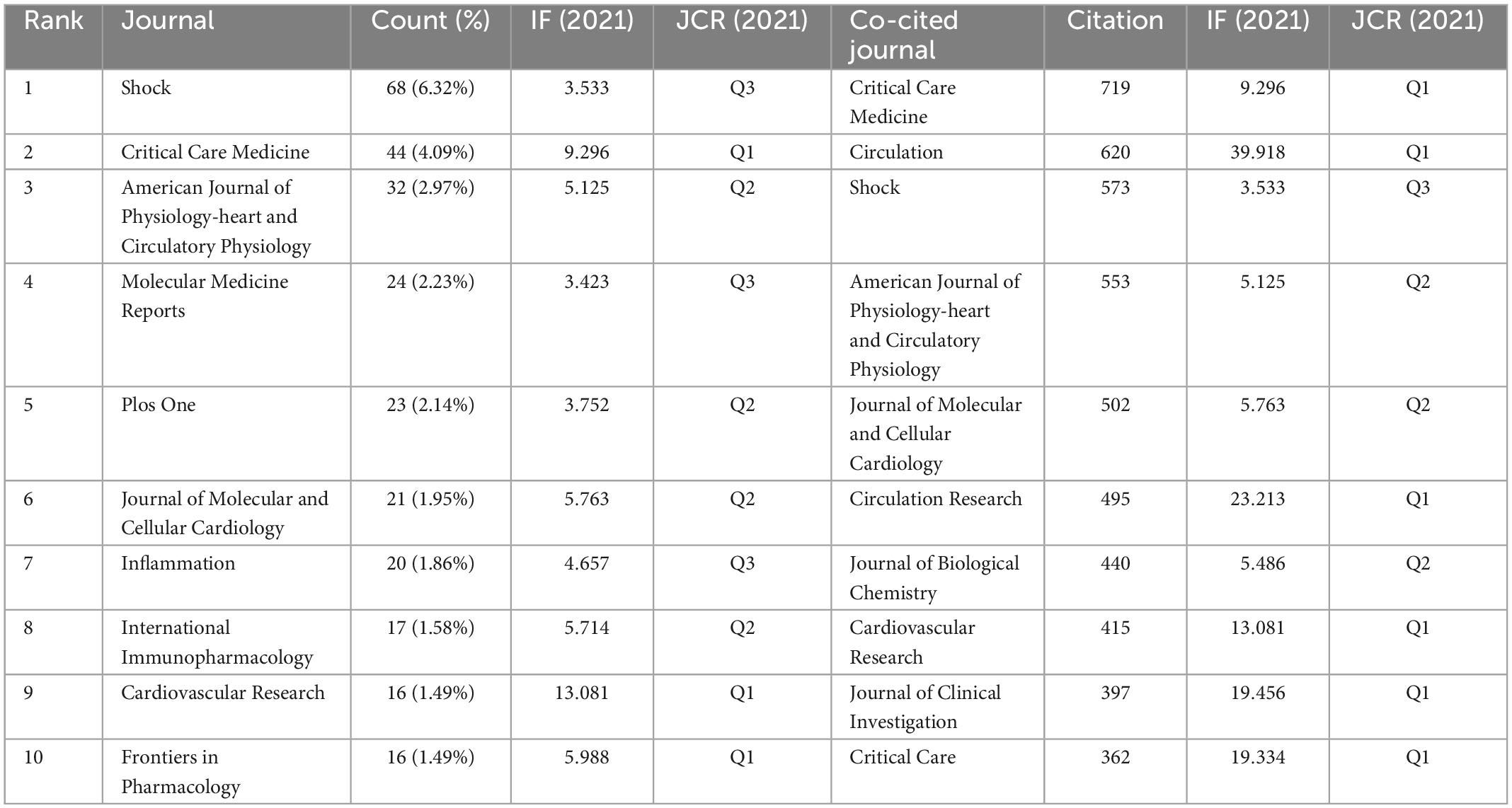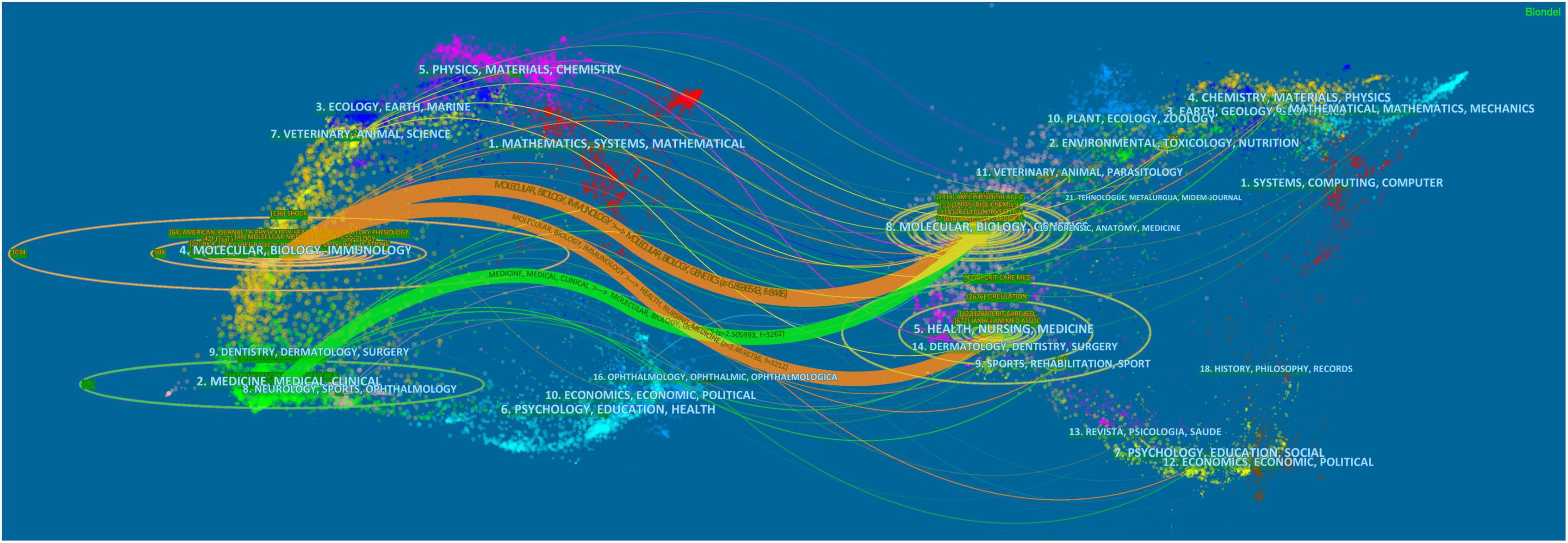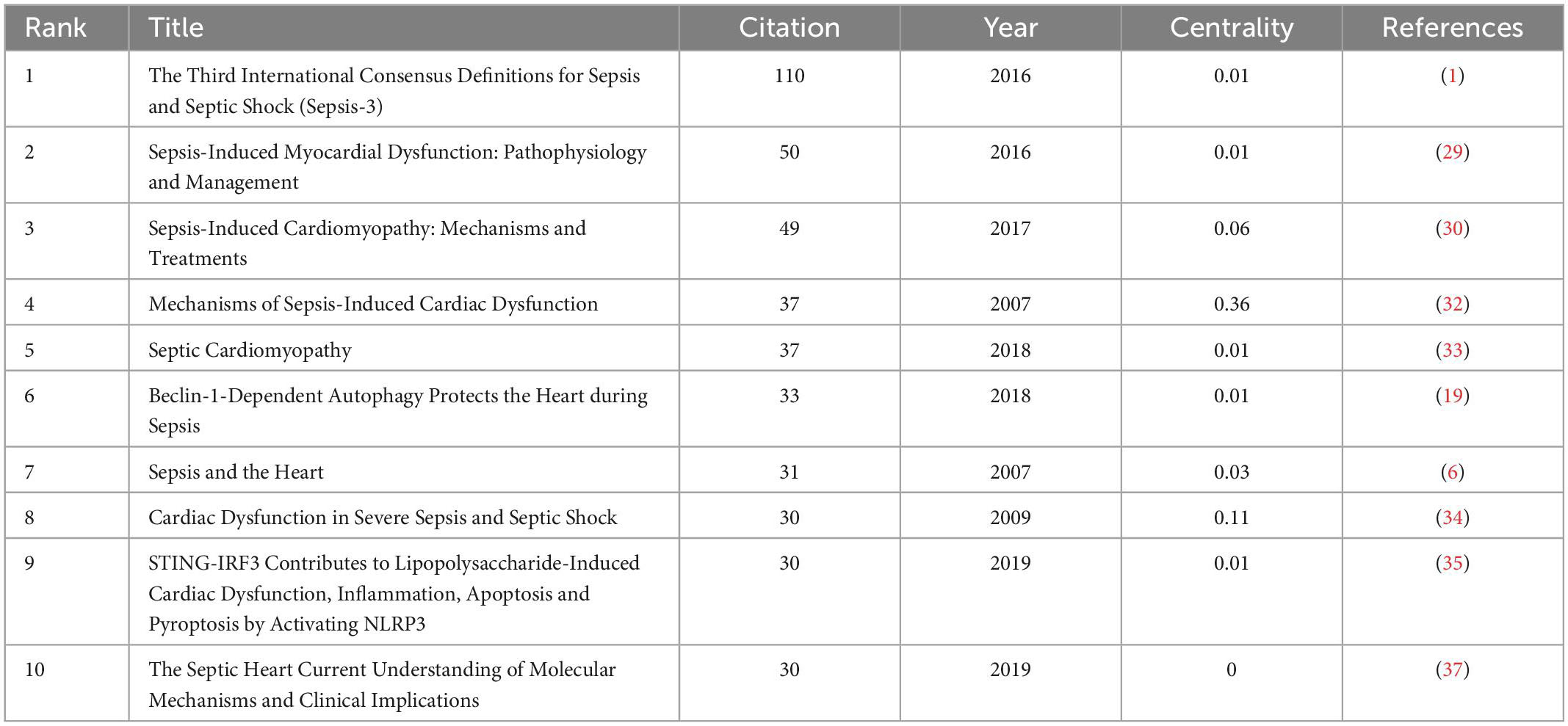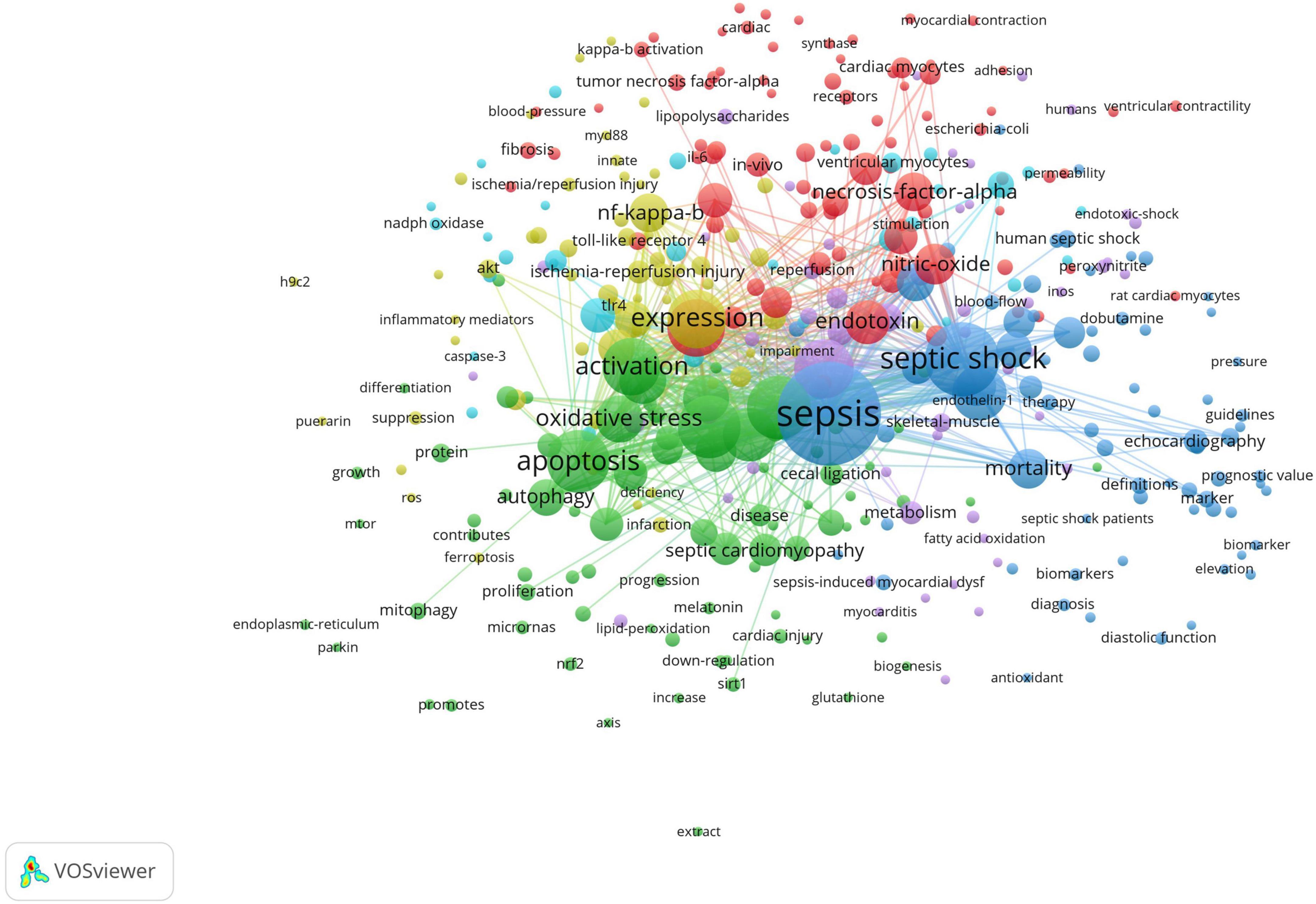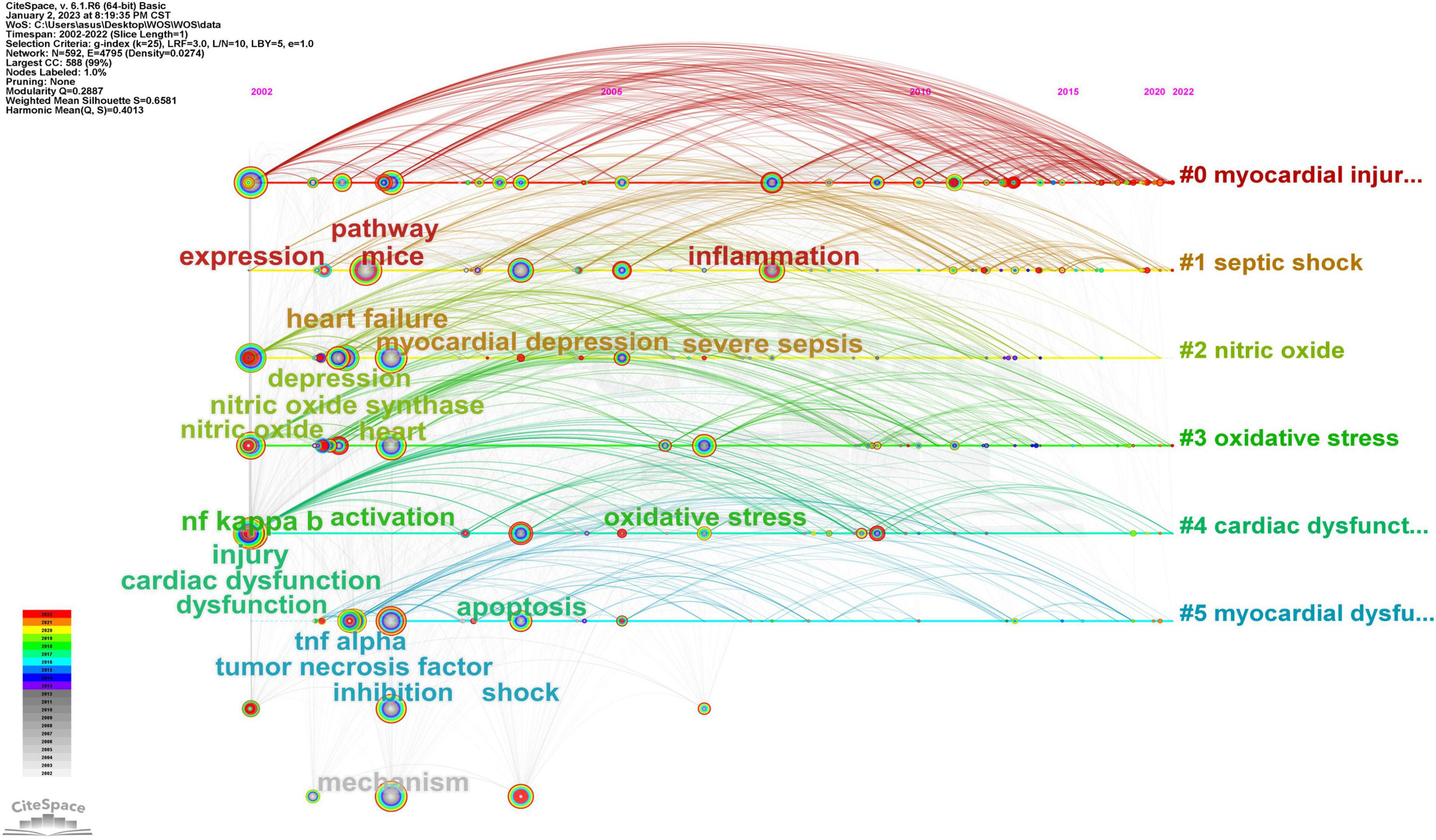- 1Department of Cardiovascular Surgery, The Second Xiangya Hospital, Central South University, Changsha, China
- 2Clinical Center for Gene Diagnosis and Therapy, The Second Xiangya Hospital, Central South University, Changsha, China
- 3Department of Cardiovascular Medicine, The Second Xiangya Hospital, Central South University, Changsha, China
Background: Sepsis-induced myocardial dysfunction (SIMD) has a significant contribution to sepsis-caused death in critically ill patients. In recent years, the number of published articles related to SIMD has increased rapidly. However, there was no literature that systematically analyzed and evaluated these documents. Thus, we aimed to lay a foundation for researchers to quickly understand the research hotspots, evolution processes and development trends in the SIMD field via a bibliometric analysis.
Methods: Articles related to SIMD were retrieved and extracted from the Web of Science Core Collection on July 19th, 2022. CiteSpace (version 6.1.R2) and VOSviewer (version 1.6.18) were used for performing visual analysis.
Results: A total of 1,076 articles were included. The number of SIMD-related articles published each year has increased significantly. These publications mainly came from 56 countries, led by China and the USA, and 461 institutions, but without stable and close cooperation. As authors, Li Chuanfu published the most articles, while Rudiger Alain had the most co-citations. Shock was the journal with the most studies, and Critical Care Medicine was the most commonly cited journal. All keywords were grouped into six clusters, some of which represented the current and developing research directions of SIMD as the molecular mechanisms.
Conclusion: Research on SIMD is flourishing. It is necessary to strengthen cooperation and exchanges between countries and institutions. The molecular mechanisms of SIMD, especially oxidative stress and regulated cell death, will be critical subjects in the future.
1. Introduction
According to the latest recommendations, called sepsis-3, sepsis is defined as a life-threatening organ dysfunction caused by a dysregulated host response to infection (1). Sepsis is one of the most important causes of death in critically ill patients, and sepsis-induced myocardial dysfunction (SIMD) has a significant contribution to this situation (2). The cardiac function of patients with SIMD can return to a normal level gradually after the primary disease is cured, so SIMD is considered as a functional cardiac disease secondary to sepsis (3). According to evidence, more than forty percent of patients with severe sepsis and septic shock have cardiac involvement (4), and myocardial dysfunction increases mortality in such patients by about fifty percent (5). In addition, SIMD is also an independent predictor of prognosis for patients (6).
In recent years, the number of published articles related to SIMD has increased rapidly. However, there is no literature that systematically analyzed and evaluated these documents. Bibliometrics, first proposed by Alan Pritchard in 1969, can analyze a large number of documents in a designated field of study by using mathematical and statistical methods (7). As a result, it can assist researchers in quickly understanding the research status and hotspots in the field, as well as forecasting its development trend (8). Based on this, many researchers have used bibliometric analysis to study their respective domains (9–12).
In this study, we used CiteSpace (version 6.1.R2) and VOSviewer (version 1.6.18) to summarize the hotspots and reveal the development trends of SIMD in the past 20 years. It aimed to lay a foundation for researchers to quickly understand the research hotspots, evolution processes and development trends in the SIMD field.
2. Materials and methods
2.1. Data collection
Data was retrieved and extracted from the Web of Science Core Collection (WOSCC) on July 19th, 2022. TS = [(sepsis OR septic OR LPS OR endotoxin OR lipopolysaccharide) AND (heart OR cardiac OR myocardial OR cardiomyocyte dysfunction)] was entered into the search formula. The retrieval time range was from July 19th, 2002 to July 19th, 2022, and language was not limited. A total of 21,454 papers (no duplicates) were gathered, including 19.055 articles and 2,399 reviews. In order to ensure sufficient correlation between literature content and SIMD and reduce the number of literatures to be screened, we used correlation ranking in WOSCC and selected the top 2,000 literatures for detailed screening. These papers were screened according to the following criteria by two independent researchers. Inclusion criteria: (1) the title of the literature deals with SIMD or its synonyms; (2) the background of the literature is related to SIMD; (3) the subjects were patients with SIMD, or the materials were animal or cell models of SIMD; (4) the purpose and conclusion of the literature are related to the mechanism, etiology, diagnosis, treatment or prognosis of SIMD. Exclusion criteria: (1) the main content and central idea of the literature have little association with SIMD; (2) the type of the literature is review, case report or meta-analysis; (3) the content of the literature is clinical treatment guidelines or consensus; (4) WOSCC could not provide complete information about the literature, including title, abstract, keywords, authors and institutions. Articles only need to meet one of these requirements to be included or excluded. Finally, after checking, a total of 1,076 eligible articles were decided for subsequent analysis and were exported in the form of “Full Record and References” and saved as a plain text file named download_txt (Figure 1).
2.2. Data analysis
All relevant data were gathered from the WOSCC. Microsoft Office Excel 2019 was used to manage data, analyze and visualize the annual distributions of articles. CiteSpace (version 6.1.R2) and VOSviewer (version 1.6.18) were used for performing visual analysis, including the distribution of institutions, contributions of authors, core journals and viewers of keywords and timelines.
CiteSpace is a JAVA-based computer system developed by Chaomei Chen for data analysis and visualization (13). Since its publication, CiteSpace has become one of the most commonly used visual analysis software in bibliometrics (11). It provides multiple perspective analyses for the particular study field to present the rules and distribution in visualization, which help researchers visually distinguish the research hotspots and the development process of the field and predict future development trends (14).
VOSviewer is a software for graphical representation of bibliometric maps developed by Nees Jan van Eck and Ludo Waltman (15). Compared with SPSS, this program is more suitable for large maps because of its powerful graphics processing capabilities. Moreover, its ability to density map is irreplaceable in current bibliometrics (16).
3. Results
3.1. The annual growth trend of publications
The number of papers concerning SIMD was counted on an annual basis, which showed an increasing trend (Figure 2). In 2002, there were fewer articles related to SIMD. From 2003 to 2015, the popularity of SIMD was relatively stable, the number of related articles fluctuated at a low level, and the overall increase was very slight. From 2016 to 2018, the annual number of related articles published increased, which indicates that more researchers paid attention to SIMD in that period. Since 2018, the number of SIMD-related research results has increased rapidly, which trend is evident, although data for 2022 is not fully collected because of the deadline for data collection in our study.
3.2. Distribution of countries/regions and institutions
A total of 1,076 articles were co-authored by researchers from 56 countries and 461 institutions. The country with the largest number of publications is China (551, 51.21%), with the USA (253, 23.51%) in second place, followed by Germany (77, 7.16%), Canada (64, 5.95%), and other countries (Table 1 and Figure 3). Among the top 10 countries, the USA (0.38), Germany (0.37), and France (0.3) have higher centrality, while China (0.17), Italy (0.15), and England (0.1) are in the second tier (Table 1), which is inconsistent with the ranking of the number of publications. The institution that published the most articles was Wuhan Univ (37, 3.44%), followed by China Med Univ (25, 2.32%), Nanjing Med Univ (23, 2.14%), Jinan Univ (22, 2.04%), and others (Table 1). Notably, the top 10 institutions are all from China.
In Figure 4, institutions are represented by nodes, and the cooperative relationships between institutions are represented by the lines between nodes. The color and thickness of the lines represent the time and degree of cooperation, respectively. It is clear that cooperation between institutions has been fairly evenly distributed over the past 20 years. However, there is a lack of stable and close cooperation between the vast majority of institutions.
3.3. Authors and co-cited authors
A total of 694 authors contributed to the publication of the 1,076 articles included in this analysis. Li Chuanfu (12, 1.12%) had published the most, followed by Deng Wei (8, 0.74%), Tang Qizhu (7, 0.65%), and others (Table 2). However, all of the top 10 authors had low centrality (0). It seemed to suggest that the contributions and influence of authors in the field of SIMD were scattered, and that there was no author acting as a bridge character. Unlike institutions, authors formed many independent collaborating teams with close cooperation, such as the team centered on Li Chuanfu and Liu Li, on Deng Wei and Tang Qizhu, and on Neviere R and Lancel S (Figure 5). In addition, it was interesting and reasonable that the same author might belong to different teams in different years, like Wen Ri for example.
Co-cited authors are different authors cited in one or more articles simultaneously. Only seven of the 1,058 cited authors from 1,076 analyzed objects were cited more than 150 times. The most frequently co-cited authors were Rudiger Alain (238), Kumar Anand (224), Singer Mervyn (224), Parrillo Joseph E (212), and etc. (Table 2).
3.4. Journals and co-cited journals
VOSviewer (version 1.6.18) was used to perform visual analyses of published journals and co-cited journals.
The 1,076 papers included in the analysis were published in 361 journals. The journal Shock (68, 6.32%) occupied the largest number (Table 3). Only Shock, Critical Care Medicine (44, 4.09%) and American Journal of Physiology-Heart and Circulatory Physiology (32, 2.97%) published more than 30 articles. Besides, according to the 2021 journal citation reports (JCR), the top 10 journals were almost evenly distributed among Q1 (3, 30%), Q2 (4, 40%), and Q3 (3, 30%). Cardiovascular Research (13.081) had the highest impact factor (IF) of these journals.
To some extent, the number of citations that a journal receives indicates its influence in a particular field. In the last 20 years, eight journals have been cited more than 400 times (Table 3). The most co-cited journal was Critical Care Medicine (719), followed by Circulation (620), Shock (573), American Journal of Physiology-Heart and Circulatory Physiology (553), Journal of Molecular and Cellular Cardiology (502), and etc. Meanwhile, sixty percent of the top 10 co-cited journals were in Q1 region.
The dual-map overlay of journals can clearly show the distribution of journals and the citation relationship between journals on the left and corresponding co-cited journals on the right (Figure 6). In this way, three main reference paths were identified. It indicated that papers published in Molecular/Biology/Genetics journals were often cited by Molecular/Biology/Immunology and Medicine/Medical/Clinical journals, and that papers published in Health/Nursing/Medicine were also often cited by Molecular/Biology/Immunology.
3.5. Co-cited references and references burst
CiteSpace was used to analyze the co-cited references. As shown in Table 4, The Third International Consensus Definitions for Sepsis and Septic Shock (Sepsis-3) (110) had a much higher number of citations than other cited references. Mechanisms of Sepsis-Induced Cardiac Dysfunction (0.36) had the best centrality, and the centrality of Cardiac Dysfunction in Severe Sepsis and Septic Shock (0.11) was also a little greater than 0.10.
The term “reference burst” refers to a state in which the number of citations of this reference increases rapidly. In the visualization map of references with citation bursts performed by CiteSpace (Figure 7), the blue bars represent the timelines of corresponding articles from their publication to the present, and the red bars represent the timelines of citation bursts from their beginning to ending. The top fifty references with the strongest citation bursts started in 2002, and the reference with the strongest burst was from Singer M, published in 2016, and the burst strength of which was 26.24 as shown. Lastly and most importantly, the burst of 29 references (58%) in the top fifty references occurred in the last 10 years, and 12 references (24%) were still in the citation burst state in 2022, which implied that SIMD might attract sustained attention and have explosive development in the future.
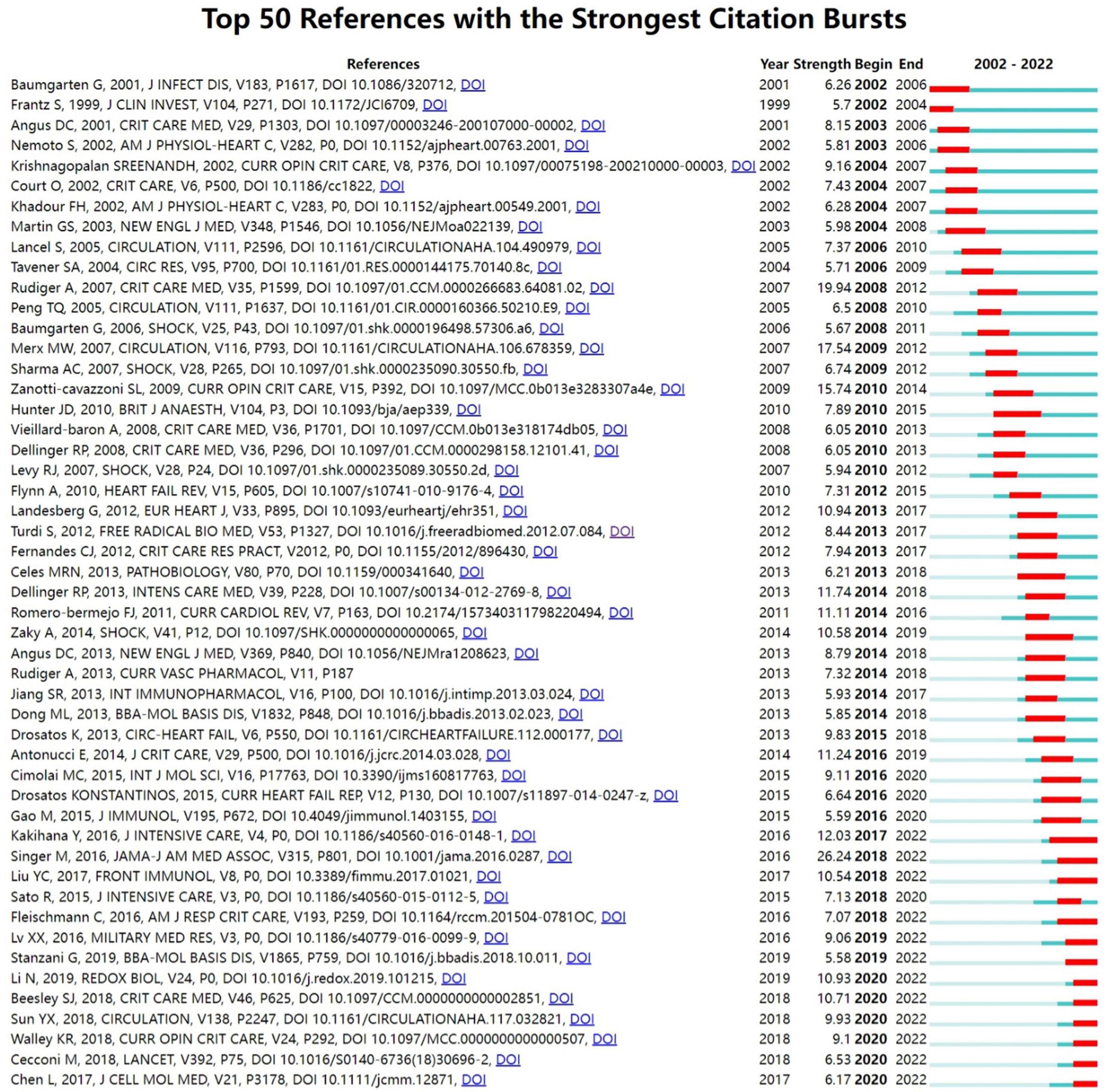
Figure 7. CiteSpace visualization map of top fifty references with the strongest citation bursts related to SIMD.
3.6. Keywords co-occurrence and hotspots analysis
Key words are the core words used to express opinions in a paper and are also the prompt words for readers to consider whether it is necessary to read the paper. It means that research hotspots and directions in specific fields can be discovered and revealed through the co-occurrence of related keywords. A total of 820 different keywords were extracted from the 1,076 articles by CiteSpace, and the top 20 keywords appeared more than 100 times (Table 5). In research related to SIMD, the most common keywords were septic shock (375) and sepsis (372), followed by dysfunction (297), activation (241), expression (235), and etc. These topics are the hotspots of SIMD-related researches.
Clustering keywords on the node graph is helpful to explore the potential relationship between keywords, which was implemented via VOSviewer (minimum number of occurrences of a keywords ≥ 5) in this study. In Figure 8, each node represents a keyword, and different colors represent different clusters. All the keywords were grouped into six clusters, namely, six research directions or areas, which were cluster 1 (red), cluster 2 (green), cluster 3 (blue), cluster 4 (yellow), cluster 5 (purple), and cluster 6 (cyan). The main members of the red cluster were lipopolysaccharide, endotoxin, nitric-oxide, necrosis-factor-alpha, and cytokines. Them of the green cluster were dysfunction, apoptosis, inflammation, activation, and cardiac dysfunction. Them of the blue cluster were sepsis, septic shock, myocardial dysfunction, mortality and severe sepsis. While the keywords of the yellow cluster mainly included expression, nf-kappa-b, lps, mice and survival, those of the purple cluster included heart, receptor, metabolism, stress and in vitro. Lastly, the cyan cluster included cardiomyocytes, contractility, phosphorylation, kappa-b and calcium.
A timeline viewer combines keyword clustering with time, which helps to show the evolution process of keywords in each cluster and the development trajectory of research hotspots in the whole field. CiteSpace was used to build the timeline viewer for these keywords (Figure 9). In this figure, the nodes on the timeline represent keywords at the time when they first appeared. The line between two points indicates that two keywords appear in the same article, while the color of the line indicates the year that the article was published. Therefore, it is obviously that most of the important keywords were proposed between 2002 and 2004. From 2002 to 2012, the research mainly focused on cardiac dysfunction in sepsis and its mechanistic relationship with inflammation. The key words of this period were mainly sepsis, septic shock, dysfunction, heart failure, myocardial dysfunction, cardiac dysfunction, injury, heart, expression, lipopolysaccharide, oxidative stress, inflammatory response, and etc. From 2013 to 2022, more studies focused on the relationship between SIMD and oxidative stress, as well as regulated cell death as a derivative. Some new keywords appeared in this period and became cores with parts of old ones, including autophagy, protect, myocardial injury, cardiomyocyte, cardiomyopathy, heme oxygenase 1, and pyroptosis.
4. Discussion
4.1. General information
The annual distribution of the articles helps to reflect the development trend of the SIMD research field (17). As shown in Figure 2, the number of articles published overall has increased. Specifically, in 2002, only 13 articles related to SIMD were published. From 2003 to 2015, SIMD was still in its infancy when the annual research results were limited, and the research heat remained at a low level. Since 2016, the research results of SIMD have begun to increase. The reason for this phenomenon might be that a new definition of sepsis had been proposed, which was called sepsis-3 and was considered as a more reasonable, accurate and applicable diagnostic criteria in the clinic (1, 18). Since 2018, the SIMD field has developed rapidly compared to before. The most successful case was Beclin-1-Dependent Autophagy Protects the Heart during Sepsis, published in 2018, demonstrating autophagy as a regulatory mechanism of SIMD, and this attracted more researchers to explore the mechanism of SIMD from the perspective of molecular biology rather than pathophysiology (19).
The field was very distinctive in its distribution of countries/regions and institutions. As shown in Table 1, the largest number of published papers was from China (551, 51.21%), followed by the USA (253, 23.51%), and the combined number of articles from the two countries accounted for 74.72% of the total (Figure 3). This indicates that China and the USA are the leading countries on SIMD. However, it was not consistent with centrality, a metric that measures the importance of each node in a network. The USA (0.38) had the best centrality and was in the first tier with Germany (0.37) and France (0.3), while China (0.17), Italy (0.15), and England (0.1) had lower ones. It seems that China should strengthen cooperation with other countries in this field to increase its influence (20). The low centrality might also be due to the fact that research results are distributed too widely across institutions. The top 10 institutions with the most published articles were all from China, but Wuhan Univ, which ranked the 1st, only published 37 articles (3.44%) with a centrality of 0.02. Meanwhile, China Med Univ (25, 2.32%) and Nanjing Med Univ (23, 2.14%) reached the highest centrality of 0.12. This information was consistent with the node diagram in Figure 4, showing that most institutions had no strong and tight cooperative relationships with others.
In the analysis of authors, Li Chuanfu, from East Tennessee State University, made the most significant contribution with 12 published articles, followed by Deng Wei (8, 0.74%) and Tang Qizhu (7, 0.65%) from Renmin Hospital and Cardiovascular Research Institute of Wuhan University and others (Table 2). LIU LI from the First Affiliated Hospital of Nanjing Medical University, who belonged to the same team as Li Chuanfu (Figure 5), was also in the top 10 with six published articles. It was noteworthy that Li Chuanfu and his team had been devoted to exploring the molecular mechanism and potential therapeutic targets of SIMD in recent years. Their main research directions, particularly in the last 10 years, have been phosphatidylinositol 3-kinase (PI3K)/protein kinase B (Akt) signaling pathway (21–23), apoptotic signaling (24, 25), and endothelial exosome (26, 27). They have proven in a mouse model of sepsis induced by cecal ligation and puncture that the PI3K/Akt is suppressed in SIMD (21), and the activation of this pathway by α-lipoic acid and toll-like receptor 9 helps prevents and treat SIMD (22, 23). They also suggests the regulatory role of nuclear factor κB and p53-mediated apoptosis on SIMD, as lentivirus expressing miR-125b/tumor necrosis factor receptor-associated factor 6 and glycolytic metabolism were believed to have a certain effect on SIMD by regulating such apoptotic signaling (24, 25). More importantly, the latest research results from Li showed that endothelial exosomes had a regulatory effect on SIMD, which was attributed to a macrophage pro-inflammatory response regulated by heat shock protein A12B, a protein predominantly expressed in endothelial cells, via suppression of adhesion molecule expression (26, 27). In conclusion, Li’s studies provided some ways for the prevention and treatment of SIMD. Besides, in the analysis of co-cited authors, only seven of the 1,058 cited authors were cited more than 150 times. The most frequently co-cited author was Rudiger Alain (238), as his work has provided the most influential research foundation in the field.
According to Table 3, the journals with the most articles about SIMD were Shock (68, 6.32%), followed by Critical Care Medicine (44, 4.09%), American Journal of Physiology-Heart and Circulatory Physiology (32, 2.97%), and etc. This indicated that the research hotspots of SIMD might mainly focus on clinical medicine and physiology in the last 20 years. As for co-cited journals, Critical Care Medicine (719) had the most citations and contributions, followed by Circulation (620), Shock (573), American Journal of Physiology-Heart and Circulatory Physiology (553), Journal of Molecular and Cellular Cardiology (502), and etc. Six of the top 10 co-cited journals belonged to Q1 in 2021, implying that high-impact journals provided credible theoretic or data bases for SIMD-related research (28). In addition, the dual-map overlay of journals on SIMD (Figure 6) showed that papers published in Molecular/Biology/Genetics journals were often cited by Molecular/Biology/Immunology and Medicine/Medical/Clinical journals, and that papers published in Health/Nursing/Medicine were also often cited by Molecular/Biology/Immunology. It seemed that both basic research and translational medicine were of great importance and attention to the SIMD research field currently.
4.2. Knowledge base
Knowledge base is composed of References with more co-citations, that are generally considered to provide a more widely recognized research basis for the corresponding field (20), these references can be obtained through co-cited analysis of references from literature (11). This study shows the top 10 references with the most co-citations (Table 4), a description of which is given in detail below.
Nineteen researchers from eighteen institutions, led by Mervyn Singer, published the most frequently cited reference in JAMA in 2016, titled The Third International Consensus Definitions for Sepsis and Septic Shock (Sepsis-3) (1). This study was a clinical guideline and expert consensus which revised the definition of sepsis to life-threatening organ dysfunction caused by a dysregulated host response to infection, called sepsis-3. Furthermore, this study revised the diagnostic criteria for sepsis based on the Sequential Organ Failure Assessment (SOFA) score, redecided the definition and diagnostic criteria for septic shock, and proposed a new sepsis screening standard called quick SOFA (qSOFA). These contributions helped to provide early diagnosis, management and treatment for sepsis patients or those at risk of sepsis, improve the consistency of relevant epidemiological studies and clinical trials, and attract researchers from non-infectious and immune fields to pay attention to the basic research of sepsis.
The second most cited reference was a review titled Sepsis-Induced Myocardial Dysfunction: Pathophysiology and Management, published by Yasuyuki Kakihana and others in 2016 in Journal of Intensive Care (29). This review outlined some characteristics of SIMD and assessed the most common underlying mechanisms, including global ischemia, myocardial depressants, cytokines and nitric oxide, damage-associated molecular patterns represented by histones and HMGB1.
The third reference was also a review, which was published by Yancun Liu in Frontiers in Immunology in 2017 and titled Sepsis-Induced Cardiomyopathy: Mechanisms and Treatments (30). This review summarized the mechanisms and treatments of SIC, especially from the perspective of molecular biology, such as toll-like receptor 4, nuclear factor κB, peroxisome proliferator-activated receptor, and etc. It is worth emphasizing that this review used another concept, sepsis-induced cardiomyopathy, which was first proposed by Elio Antonucci in 2014 in an attempt to define sepsis-induced myocardial depression as a disease rather than a pathological condition (31). However, this concept is still not widely recognized and used in clinical practice.
The fourth reference presented in Table 4 was published by Alain Rudiger in 2007 in Crit Care Medicine and had the highest centrality (0.36) (32). This review suggested that myocardial depression with reduced ejection fraction occurred in half of patients with sepsis, but that this reduction in cardiac function was reversible, so cardiomyocyte death was likely to be rare in such a process. The fifth one was published by Sarah J Beesley in 2018 and also in Crit Care Medicine (33). This review focused more on clinical applications and believed that treatment of sepsis-induced cardiac dysfunction had a more significant impact on prognosis, especially when the cardiac function of patients with sepsis decreased a lot. The sixth one was published by Yuxiao Sun in 2018 in Circulation (19). In this study, mouse models of lipopolysaccharide induced sepsis were used to conduct experiments which suggested that beclin-1-dependent autophagy might protect the heart from sepsis. Its discussion in conjunction with the fifth reference suggested that although cell death was rare in septic hearts, in all probability, regulating cell death might still have potential therapeutic effects on SIMD. The seventh was published by M W Merx in 2007 and also in Circulation (6), which did nearly the same as the second reference, but seemed to pay more attention to the role of regional myocardial ischemia or infarction secondary to coronary artery disease in SIMD. The eighth was published by Sergio L Zanotti-Cavazzoni in 2009 in Current Opinion in Critical Care (34), which also outlined some characteristics of SIMD and assessed the most common underlying mechanisms, and focused more on the effects of nitric oxide expression, mitochondrial dysfunction and apoptosis in SIMD. The nineth was published by Ning Li in 2019 in Redox Biology (35). This article reported that stimulators of interferon genes might activate NOD-like receptor protein 3 through phosphorylating type-I interferon regulatory factor 3 in a lipopolysaccharide-induced mouse sepsis model. Meanwhile stimulators of interferon gene deficiency could facilitate the alleviation of SIMD in mice. Besides, the NOD-like receptor protein 3 inflammasome was a classic agonist and biomarker of pyroptosis (36), which strongly suggested that pyroptosis was involved in the occurrence of SIMD. The tenth was published by Lukas Martin in 2019 in Chest (37). This review provided an overview of the most current, compared to the other top 10 references, understanding of SIMD in mechanisms, diagnosis, treatment and long-term outcome, and had a particular focus on pathophysiology.
Overall, the top 10 most co-cited references included one clinical guideline and expert consensus, seven domain reviews, and two original experimental articles, and nine of them were from Q1 journals with the highest IF (157.335) from The Third International Consensus Definitions for Sepsis and Septic Shock (Sepsis-3). In these studies, the focus of the reviews was to summarize the known mechanisms involved in or regulating SIMD and potential therapeutic targets of SIMD, while the common point of the original articles was to demonstrate that the regulated cell death was related to the mechanism or regulation of SIMD.
4.3. The analysis of hotspots and frontiers
In bibliometrics, keywords are the most important research objects, because the hot spots and tendencies of the research field can be reflected by keyword co-occurrence analysis, knowledge structure and secondary fields can be obtained by improving keyword cluster analysis, and the evolution process and trend of hot spots can be gained by constructing a timeline view (38). As shown in Table 5, the top 20 keywords all appeared more than 100 times. They represented research hotspots in the SIMD field, of which the more representative ones were septic shock (375), sepsis (372), dysfunction (297), activation (241), and expression (235). The node size of the visualization map of keywords clustering analysis can also visually reflect high-frequency keywords in the field (Figure 8). However, the most important feature of keyword clustering analysis is to reveal research directions and knowledge structure (39). In this study, all the keywords were grouped into six clusters (Figure 8). Cluster 1 (red) was involved in inflammation in SIMD, cluster 2 (green) was related to sepsis-induced cardiac function change and its underlying mechanisms, and cluster 3 (blue) was with regard to epidemiological studies related to SIMD. Meanwhile, keywords of cluster 4 (yellow) were relative to animal models, mainly rats in the early period and mice in recent 10 years (40–44), of SIMD and in vivo experiments; of cluster 5 (purple) were in terms of cell models of SIMD and in vitro experiments; and of cluster 6 (cyan) were associated with molecular mechanisms of SIMD. In addition, the knowledge structure of SIMD could be considered as constructed from septic shock, sepsis, dysfunction, activation, expression, heart, myocardial dysfunction, cardiac dysfunction, and etc., which all belonged to cluster 1, cluster 2, and cluster 3. This indicated that, on the whole, research on SIMD in the last 20 years had focused more on clinical manifestations and epidemiology than on pathophysiology or molecular biology, which was probably due to the limitations of the previous definition of sepsis, Sepsis-2. From 2001 to 2016, Sepsis-2 was a widely accepted definition of sepsis, which defined sepsis to be the clinical syndrome defined by the presence of both infection and a systemic inflammatory response (45). This definition, derived entirely from clinical medicine, limited the depth of research on mechanisms of SIMD. Until the definition of sepsis was updated to Sepsis-3 in 2016 (1), the diagnosis and targeted treatment of patients with sepsis were more reasonable (46), while more researchers paid attention to pathophysiological process and related molecular mechanisms, such as endoplasmic reticulum stress (47), cardiovascular hyperpermeability (48), regulated cell death, macrophage polarization (49), mitochondrial dysfunction (50), fatty acid oxidation (51), calcium metabolism disorder (52), autonomic nervous dysregulation (53), and etc. Such a transformation was generally consistent with the results of the timeline viewer, but non-immune-related keywords began to appear in 2013, slightly earlier than the year of Sepsis-3 publication (Figure 9).
Citation bursts analysis is another way to detect emerging concepts and potential hotspots in a given research field in bibliometrics, applied to explore the abrupt change points and active research frontiers in the development of a field (54). Citation bursts analysis of references as circumstantial evidence was used in this study. The top fifty references with the strongest citation bursts were selected and shown in Figure 7. Currently, 12 of the top fifty references are experiencing a citation burst, while 6 literatures have been in this status for years (years: 2020–2022). Therefore, these 12 references were considered to reflect the latest research direction of SIMD. The orders of them based on the strength of the citation bursts (from high to low) were as followed. The references with the first (26.24) (1), second (12.03) (29), third (10.93) (35), fourth (10.71) (33), fifth (10.54) (30), and sixth (9.93) (19) highest strengths were coincident with the most frequently cited references described before in the section “Knowledge base.” This indirectly indicated that the research results related to SIMD had exploded in the last 3 years, which could corroborate each other with the annual growth trend (Figure 2). The seventh (9.1), published by Keith R Walley in 2018 in Current Opinion in Critical Care (55), and the eighth (9.06), published by Xiuxiu Lv in 2016 in Military Medical Research (56), were both reviews of SIMD focused on a physiologic and pathophysiological context. The nineth one (7.07) was a meta-analysis published by Carolin Fleischmann in 2016 in American Journal of Respiratory and Critical Care Medicine, which indicated that population-level epidemiologic data for sepsis was severely lacking in low- and middle-income countries. The tenth reference (6.53) was a review published by Maurizio Cecconi in 2018 in Lancet with the highest IF (202.731) of these references, which concluded that ongoing research aimed to improve the definition of patient populations to allow for individualized management strategies matched to a patient’s molecular and biochemical profile (57). The eleventh one (6.17) was an original article published by Lvyi Chen in 2017 in Journal of Cellular and Molecular Medicine (58). The results suggested that salidroside could be a potential therapeutic agent for the treatment of SIMD via regulating the PI3K/Akt pathway, which was exactly consistent with the results from Li Chuanfu and his team listed in the section “General information” (21). The last one (5.58) was another review published by Giacomo Stanzani in 2019 in Biochimica et Biophysica Acta-Molecular Basis of Disease, which focused on disrupted mitochondrial processes (59).
According to the above analyses, it is obviously that the research hotspots of SIMD initially focused on epidemiological features and the relationship with infection, and more recently focused on inflammatory response and molecular biological mechanisms. Recent studies have revealed some SIMD-related critical targets, including calpain (60, 61), heme oxygenase-1 (62, 63), Toll-like receptors (64, 65), NOD-like receptor protein 3 (66, 67), and silent information regulator 1 (68, 69). Oxidative stress and regulated cell death were likely to be the main directions and ideas for future studies on the molecular mechanisms of SIMD. However, although a few clinical studies have been conducted (70–72), evidence for SIMD-related clinical trials is still lacking.
4.4. Limitation
To begin with, the data were downloaded from the WOSCC database, meaning that literature not included in the database would not be included in the initial search, even if it was included in other WOS databases. Besides, the uneven quality of data might have a negative impact on the credibility of the map analysis. Meanwhile, the process of bibliometric analysis might lead to bias, as has been reported in other articles using the same method (73, 74). Nevertheless, visual analysis based on large volumes of literature lays an undoubted foundation for researchers to quickly understand the research hotspots, evolution processes and development trends in the SIMD field.
5. Conclusion
We collected the studies with high correlation with SIMD from 2002 to 2022 and analyzed the research hotspots, evolution process and development trend of SIMD. From the perspective of molecular biology, it is of outstanding value to study the pathogenesis and potential therapeutic targets of SIMD. According to the visual analysis by CiteSpace and VOSviewer, the number of papers concerning SIMD shows an increasing trend. The main countries concerned with this topic are China and the USA, while Wuhan University in China is the institution with the highest influence on achievements. However, cooperation and communication among countries and institutions need to be strengthened. Li Chuanfu has made significant contributions to the SIMD field. Most articles on SIMD have been published in internationally influential journals and focus on both basic research and translational medicine. Epidemiological features and the relationship with infection are key points for SIMD in the early period, but the molecular mechanisms of SIMD, particularly oxidative stress and regulated cell death, will be critical in the future.
Data availability statement
The original contributions presented in this study are included in the article/supplementary material, further inquiries can be directed to the corresponding author.
Author contributions
WZ and YY developed the topic and invited DL, HY, HZ, SL, YH, ZY, ZZ, and ZX. HY organized and edited the manuscript. ZZ and SL screened data and prepared figures and tables. DL and ZY prepared the section “General information.” ZX, YH, and HZ prepared the section “Knowledge base.” All authors have contributed to the content of this manuscript, reviewed and approved it for accuracy, completeness, and final manuscript.
Funding
This study was supported by the China Medical Board OC program (NO. 21-426), the Hunan Provincial Natural Science Foundation (NO. 2022JJ70062), and the Changsha Municipal Natural Science Foundation (NO. kq2202396).
Conflict of interest
The authors declare that the research was conducted in the absence of any commercial or financial relationships that could be construed as a potential conflict of interest.
Publisher’s note
All claims expressed in this article are solely those of the authors and do not necessarily represent those of their affiliated organizations, or those of the publisher, the editors and the reviewers. Any product that may be evaluated in this article, or claim that may be made by its manufacturer, is not guaranteed or endorsed by the publisher.
References
1. Singer M, Deutschman C, Seymour C, Shankar-Hari M, Annane D, Bauer M, et al. The third international consensus definitions for sepsis and septic shock (Sepsis-3). JAMA. (2016) 315:801–10. doi: 10.1001/jama.2016.0287
2. Busch K, Kny M, Huang N, Klassert T, Stock M, Hahn A, et al. Inhibition of the NLRP3/IL-1β axis protects against sepsis-induced cardiomyopathy. J Cachexia Sarcopenia Muscle. (2021) 12:1653–68. doi: 10.1002/jcsm.12763
3. Parker M, Shelhamer J, Bacharach S, Green M, Natanson C, Frederick T, et al. Profound but reversible myocardial depression in patients with septic shock. Ann Intern Med. (1984) 100:483–90. doi: 10.7326/0003-4819-100-4-483
4. Charpentier J, Luyt C, Fulla Y, Vinsonneau C, Cariou A, Grabar S, et al. Brain natriuretic peptide: a marker of myocardial dysfunction and prognosis during severe sepsis. Crit Care Med. (2004) 32:660–5. doi: 10.1097/01.ccm.0000114827.93410.d8
5. Li Z, Zhang E, Hu Y, Liu Y, Chen B. High Serum sTREM-1 correlates with myocardial dysfunction and predicts prognosis in septic patients. Am J Med Sci. (2016) 351:555–62. doi: 10.1016/j.amjms.2016.01.023
6. Merx M, Weber C. Sepsis and the heart. Circulation. (2007) 116:793–802. doi: 10.1161/CIRCULATIONAHA.106.678359
7. Shen J, Shen H, Ke L, Chen J, Dang X, Liu B, et al. Knowledge mapping of immunotherapy for hepatocellular carcinoma: a bibliometric study. Front Immunol. (2022) 13:815575. doi: 10.3389/fimmu.2022.815575
8. Ma D, Yang B, Guan B, Song L, Liu Q, Fan Y, et al. A bibliometric analysis of pyroptosis from 2001 to 2021. Front Immunol. (2021) 12:731933. doi: 10.3389/fimmu.2021.731933
9. Peng C, Kuang L, Zhao J, Ross A, Wang Z, Ciolino J. Bibliometric and visualized analysis of ocular drug delivery from 2001 to 2020. J Control Release. (2022) 345:625–45. doi: 10.1016/j.jconrel.2022.03.031
10. Chen Y, Lin M, Zhuang D. Wastewater treatment and emerging contaminants: bibliometric analysis. Chemosphere. (2022) 297:133932. doi: 10.1016/j.chemosphere.2022.133932
11. Miao L, Zhang J, Zhang Z, Wang S, Tang F, Teng M, et al. A bibliometric and knowledge-map analysis of CAR-T cells from 2009 to 2021. Front Immunol. (2022) 13:840956. doi: 10.3389/fimmu.2022.840956
12. Wang H, Shi J, Shi S, Bo R, Zhang X, Hu Y. Bibliometric analysis on the progress of chronic heart failure. Curr Probl Cardiol. (2022) 47:101213. doi: 10.1016/j.cpcardiol.2022.101213
13. Chen C. Searching for intellectual turning points: progressive knowledge domain visualization. Proc Natl Acad Sci USA. (2004) 101(Suppl 1):5303–10. doi: 10.1073/pnas.0307513100
14. Liu S, Sun Y, Gao X, Sui Y. Knowledge domain and emerging trends in Alzheimer’s disease: a scientometric review based on CiteSpace analysis. Neural Regen Res. (2019) 14:1643–50. doi: 10.4103/1673-5374.255995
15. van Eck N, Waltman L. Software survey: VOSviewer, a computer program for bibliometric mapping. Scientometrics. (2010) 84:523–38. doi: 10.1007/s11192-009-0146-3
16. Huang Y, Zhan Q, Wu C, Liao N, Jiang Z, Ding H, et al. Trends and hotspots in nanoparticles for the targeted delivery of nucleic acids: a ten-year bibliometric study. Front Pharmacol. (2022) 13:868398. doi: 10.3389/fphar.2022.868398
17. Ahmad P, Asif J, Alam M, Slots J. A bibliometric analysis of Periodontology 2000. Periodontol 2000. (2020) 82:286–97. doi: 10.1111/prd.12328
18. Cheng B, Li Z, Wang J, Xie G, Liu X, Xu Z, et al. Comparison of the performance between sepsis-1 and sepsis-3 in ICUs in China: a retrospective multicenter study. Shock. (2017) 48:301–6. doi: 10.1097/SHK.0000000000000868
19. Sun Y, Yao X, Zhang Q, Zhu M, Liu Z, Ci B, et al. Beclin-1-dependent autophagy protects the heart during sepsis. Circulation. (2018) 138:2247–62. doi: 10.1161/CIRCULATIONAHA.117.032821
20. Song L, Zhang J, Ma D, Fan Y, Lai R, Tian W, et al. A bibliometric and knowledge-map analysis of macrophage polarization in atherosclerosis from 2001 to 2021. Front Immunol. (2022) 13:910444. doi: 10.3389/fimmu.2022.910444
21. Li C, Hua F, Ha T, Singh K, Lu C, Kalbfleisch J, et al. Activation of myocardial phosphoinositide-3-kinase p110α ameliorates cardiac dysfunction and improves survival in polymicrobial sepsis. PLoS One. (2012) 7:e44712. doi: 10.1371/journal.pone.0044712
22. Jiang S, Zhu W, Li C, Zhang X, Lu T, Ding Z, et al. α-Lipoic acid attenuates LPS-induced cardiac dysfunction through a PI3K/Akt-dependent mechanism. Int Immunopharmacol. (2013) 16:100–7. doi: 10.1016/j.intimp.2013.03.024
23. Gao M, Ha T, Zhang X, Wang X, Liu L, Kalbfleisch J, et al. The Toll-like receptor 9 ligand, CpG oligodeoxynucleotide, attenuates cardiac dysfunction in polymicrobial sepsis, involving activation of both phosphoinositide 3 kinase/Akt and extracellular-signal-related kinase signaling. J Infect Dis. (2013) 207:1471–9. doi: 10.1093/infdis/jit036
24. Ma H, Wang X, Ha T, Gao M, Liu L, Wang R, et al. MicroRNA-125b prevents cardiac dysfunction in polymicrobial sepsis by targeting TRAF6-mediated nuclear factor κB activation and p53-mediated apoptotic signaling. J Infect Dis. (2016) 214:1773–83. doi: 10.1093/infdis/jiw449
25. Zheng Z, Ma H, Zhang X, Tu F, Wang X, Ha T, et al. Enhanced glycolytic metabolism contributes to cardiac dysfunction in polymicrobial sepsis. J Infect Dis. (2017) 215:1396–406. doi: 10.1093/infdis/jix138
26. Zhang X, Wang X, Fan M, Tu F, Yang K, Ha T, et al. Endothelial HSPA12B exerts protection against sepsis-induced severe cardiomyopathy via suppression of adhesion molecule expression by miR-126. Front Immunol. (2020) 11:566. doi: 10.3389/fimmu.2020.00566
27. Tu F, Wang X, Zhang X, Ha T, Wang Y, Fan M, et al. Novel role of endothelial derived exosomal HSPA12B in regulating macrophage inflammatory responses in polymicrobial sepsis. Front Immunol. (2020) 11:825. doi: 10.3389/fimmu.2020.00825
28. Qin Y, Ren S, Shao B, Qin H, Wang H, Li G, et al. The intellectual base and research fronts of IL-37: a bibliometric review of the literature from WoSCC. Front Immunol. (2022) 13:931783. doi: 10.3389/fimmu.2022.931783
29. Kakihana Y, Ito T, Nakahara M, Yamaguchi K, Yasuda T. Sepsis-induced myocardial dysfunction: pathophysiology and management. J Intensive Care. (2016) 4:22. doi: 10.1186/s40560-016-0148-1
30. Liu Y, Yu M, Shou S, Chai Y. Sepsis-induced cardiomyopathy: mechanisms and treatments. Front Immunol. (2017) 8:1021. doi: 10.3389/fimmu.2017.01021
31. Antonucci E, Fiaccadori E, Donadello K, Taccone F, Franchi F, Scolletta S. Myocardial depression in sepsis: from pathogenesis to clinical manifestations and treatment. J Crit Care. (2014) 29:500–11. doi: 10.1016/j.jcrc.2014.03.028
32. Rudiger A, Singer M. Mechanisms of sepsis-induced cardiac dysfunction. Crit Care Med. (2007) 35:1599–608. doi: 10.1097/01.CCM.0000266683.64081.02
33. Beesley S, Weber G, Sarge T, Nikravan S, Grissom C, Lanspa M, et al. Septic cardiomyopathy. Crit Care Med. (2018) 46:625–34. doi: 10.1097/CCM.0000000000002851
34. Zanotti-Cavazzoni S, Hollenberg S. Cardiac dysfunction in severe sepsis and septic shock. Curr Opin Crit Care. (2009) 15:392–7. doi: 10.1097/MCC.0b013e3283307a4e
35. Li N, Zhou H, Wu H, Wu Q, Duan M, Deng W, et al. STING-IRF3 contributes to lipopolysaccharide-induced cardiac dysfunction, inflammation, apoptosis and pyroptosis by activating NLRP3. Redox Biol. (2019) 24:101215. doi: 10.1016/j.redox.2019.101215
36. Gaul S, Leszczynska A, Alegre F, Kaufmann B, Johnson C, Adams L, et al. Hepatocyte pyroptosis and release of inflammasome particles induce stellate cell activation and liver fibrosis. J Hepatol. (2021) 74:156–67. doi: 10.1016/j.jhep.2020.07.041
37. Martin L, Derwall M, Al Zoubi S, Zechendorf E, Reuter D, Thiemermann C, et al. The septic heart: current understanding of molecular mechanisms and clinical implications. Chest. (2019) 155:427–37. doi: 10.1016/j.chest.2018.08.1037
38. Yuan X, Chang C, Chen X, Li K. Emerging trends and focus of human gastrointestinal microbiome research from 2010-2021: a visualized study. J Transl Med. (2021) 19:327. doi: 10.1186/s12967-021-03009-8
39. Ma L, Ma J, Teng M, Li Y. Visual analysis of colorectal cancer immunotherapy: a bibliometric analysis from 2012 to 2021. Front Immunol. (2022) 13:843106. doi: 10.3389/fimmu.2022.843106
40. Yang J, Wang H, Lu D, Wang Y, Qi R, Li J, et al. Effects of neutral sulfate berberine on LPS-induced cardiomyocyte TNF-alpha secretion, abnormal calcium cycling, and cardiac dysfunction in rats. Acta Pharmacol Sin. (2006) 27:173–8. doi: 10.1111/j.1745-7254.2006.00257.x
41. Hagiwara S, Iwasaka H, Maeda H, Noguchi T. Landiolol, an ultrashort-acting beta1-adrenoceptor antagonist, has protective effects in an LPS-induced systemic inflammation model. Shock. (2009) 31:515–20. doi: 10.1097/SHK.0b013e3181863689
42. Zhang J, Zhu D, Wang Y, Ju Y. Andrographolide attenuates LPS-induced cardiac malfunctions through inhibition of IκB phosphorylation and apoptosis in mice. Cell Physiol Biochem. (2015) 37:1619–28. doi: 10.1159/000438528
43. Huang S, Xu M, Wu H, Wan C, Wang H, Wu Q, et al. Isoquercitrin attenuated cardiac dysfunction Via AMPKα-dependent pathways in LPS-treated mice. Mol Nutr Food Res. (2018) 62:e1800955. doi: 10.1002/mnfr.201800955
44. Xu J, Wang L, Yang Q, Ma Q, Zhou Y, Cai Y, et al. Deficiency of myeloid Pfkfb3 protects mice from lung edema and cardiac dysfunction in LPS-induced endotoxemia. Front Cardiovasc Med. (2021) 8:745810. doi: 10.3389/fcvm.2021.745810
45. Levy M, Fink M, Marshall J, Abraham E, Angus D, Cook D, et al. 2001 SCCM/ESICM/ACCP/ATS/SIS international sepsis definitions conference. Intensive Care Med. (2003) 29:530–8. doi: 10.1007/s00134-003-1662-x
46. Crouser E, Parrillo J, Seymour C, Angus D, Bicking K, Esguerra V, et al. Monocyte distribution width: a novel indicator of sepsis-2 and sepsis-3 in high-risk emergency department patients. Crit Care Med. (2019) 47:1018–25. doi: 10.1097/CCM.0000000000003799
47. Zhang J, Zhang X, Cui Y, Cui L, Zhao P. Macrophage migration inhibitory factor knockout attenuates endotoxin-induced cardiac dysfunction in mice. Kardiol Pol. (2018) 76:871–80. doi: 10.5603/KP.a2018.0032
48. Mu X, Wang X, Huang W, Wang R, Essandoh K, Li Y, et al. Circulating exosomes isolated from septic mice induce cardiovascular hyperpermeability through promoting podosome cluster formation. Shock. (2018) 49:429–41. doi: 10.1097/SHK.0000000000000928
49. Chen X, Wang S, Liu C, Gao Y, Meng X, Wei W, et al. Losartan attenuates sepsis-induced cardiomyopathy by regulating macrophage polarization via TLR4-mediated NF-κB and MAPK signaling. Pharmacol Res. (2022) 185:106473. doi: 10.1016/j.phrs.2022.106473
50. Haileselassie B, Mukherjee R, Joshi A, Napier B, Massis L, Ostberg N, et al. Drp1/Fis1 interaction mediates mitochondrial dysfunction in septic cardiomyopathy. J Mol Cell Cardiol. (2019) 130:160–9. doi: 10.1016/j.yjmcc.2019.04.006
51. Drosatos K, Pollak N, Pol C, Ntziachristos P, Willecke F, Valenti M, et al. Cardiac Myocyte KLF5 Regulates Ppara expression and cardiac function. Circ Res. (2016) 118:241–53. doi: 10.1161/CIRCRESAHA.115.306383
52. Luo R, Chen X, Ma H, Yao C, Liu M, Tao J, et al. Myocardial caspase-3 and NF-κB activation promotes calpain-induced septic apoptosis: the role of Akt/eNOS/NO pathway. Life Sci. (2019) 222:195–202. doi: 10.1016/j.lfs.2019.02.048
53. Wei C, Louis H, Schmitt M, Albuisson E, Orlowski S, Levy B, et al. Effects of low doses of esmolol on cardiac and vascular function in experimental septic shock. Crit Care. (2016) 20:407. doi: 10.1186/s13054-016-1580-2
54. Huang X, Yang Z, Zhang J, Wang R, Fan J, Zhang H, et al. A bibliometric analysis based on web of science: current perspectives and potential trends of SMAD7 in oncology. Front Cell Dev Biol. (2022) 9:712732. doi: 10.3389/fcell.2021.712732
55. Walley K. Sepsis-induced myocardial dysfunction. Curr Opin Crit Care. (2018) 24:292–9. doi: 10.1097/MCC.0000000000000507
56. Lv X, Wang H. Pathophysiology of sepsis-induced myocardial dysfunction. Mil Med Res. (2016) 3:30. doi: 10.1186/s40779-016-0099-9
57. Cecconi M, Evans L, Levy M, Rhodes A. Sepsis and septic shock. Lancet. (2018) 392:75–87. doi: 10.1016/S0140-6736(18)30696-2
58. Chen L, Liu P, Feng X, Ma C. Salidroside suppressing LPS-induced myocardial injury by inhibiting ROS-mediated PI3K/Akt/mTOR pathway in vitro and in vivo. J Cell Mol Med. (2017) 21:3178–89. doi: 10.1111/jcmm.12871
59. Stanzani G, Duchen M, Singer M. The role of mitochondria in sepsis-induced cardiomyopathy. Biochim Biophys Acta Mol Basis Dis. (2019) 1865:759–73. doi: 10.1016/j.bbadis.2018.10.011
60. Tissier S, Lancel S, Marechal X, Mordon S, Depontieu F, Scherpereel A, et al. Calpain inhibitors improve myocardial dysfunction and inflammation induced by endotoxin in rats. Shock. (2004) 21:352–7. doi: 10.1097/00024382-200404000-00010
61. Freitas A, Figueiredo M, Campos E, Soave D, Ramos S, Tanowitz H, et al. Activation of both the calpain and ubiquitin-proteasome systems contributes to septic cardiomyopathy through dystrophin loss/disruption and mTOR inhibition. PLoS One. (2016) 11:e0166839. doi: 10.1371/journal.pone.0166839
62. Jia L, Wang Y, Wang Y, Ma Y, Shen J, Fu Z, et al. Heme oxygenase-1 in macrophages drives septic cardiac dysfunction via suppressing lysosomal degradation of inducible nitric oxide synthase. Circ Res. (2018) 122:1532–44. doi: 10.1161/CIRCRESAHA.118.312910
63. Lee Y, Cheng P, Chim L, Kung C, Ka S, Chung M, et al. Baicalein, an active component of Scutellaria baicalensis Georgi, improves cardiac contractile function in endotoxaemic rats via induction of heme oxygenase-1 and suppression of inflammatory responses. J Ethnopharmacol. (2011) 135:179–85. doi: 10.1016/j.jep.2011.03.009
64. Rameshrad M, Maleki-Dizaji N, Vaez H, Soraya H, Nakhlband A, Garjani A. Lipopolysaccharide induced activation of toll like receptor 4 in isolated rat heart suggests a local immune response in myocardium. Iran J Immunol. (2015) 12:104–16.
65. Katare P, Nizami H, Paramesha B, Dinda A, Banerjee S. Activation of toll like receptor 4 (TLR4) promotes cardiomyocyte apoptosis through SIRT2 dependent p53 deacetylation. Sci Rep. (2020) 10:19232. doi: 10.1038/s41598-020-75301-4
66. Zhang B, Liu Y, Sui Y, Cai H, Liu W, Zhu M, et al. Cortistatin inhibits NLRP3 inflammasome activation of cardiac fibroblasts during sepsis. J Card Fail. (2015) 21:426–33. doi: 10.1016/j.cardfail.2015.01.002
67. Zhang W, Tao A, Lan T, Cepinskas G, Kao R, Martin C, et al. Carbon monoxide releasing molecule-3 improves myocardial function in mice with sepsis by inhibiting NLRP3 inflammasome activation in cardiac fibroblasts. Basic Res Cardiol. (2017) 112:16. doi: 10.1007/s00395-017-0603-8
68. Zhang W, He B, Wu Y, Qiao J, Peng Z. Melatonin protects against sepsis-induced cardiac dysfunction by regulating apoptosis and autophagy via activation of SIRT1 in mice. Life Sci. (2019) 217:8–15. doi: 10.1016/j.lfs.2018.11.055
69. Guo T, Jiang Z, Tong Z, Zhou Y, Chai X, Xiao X. Shikonin ameliorates LPS-induced cardiac dysfunction by SIRT1-dependent inhibition of NLRP3 inflammasome. Front Physiol. (2020) 11:570441. doi: 10.3389/fphys.2020.570441
70. Zhang H, Wei L, Zhao G, Liu S, Zhang Z, Zhang J, et al. Protective effect of Xuebijing injection on myocardial injury in patients with sepsis: a randomized clinical trial. J Tradit Chin Med. (2016) 36:706–10. doi: 10.1016/s0254-6272(17)30003-1
71. Fuller B, Mohr N, Graetz T, Lynch I, Dettmer M, Cullison K, et al. The impact of cardiac dysfunction on acute respiratory distress syndrome and mortality in mechanically ventilated patients with severe sepsis and septic shock: an observational study. J Crit Care. (2015) 30:65–70. doi: 10.1016/j.jcrc.2014.07.027
72. Sato R, Kuriyama A, Takada T, Nasu M, Luthe S. Prevalence and risk factors of sepsis-induced cardiomyopathy: a retrospective cohort study. Medicine. (2016) 95:e5031. doi: 10.1097/MD.0000000000005031
73. Yan W, Lu S, Yang Y, Ning W, Cai Y, Hu X, et al. Research trends, hot spots and prospects for necroptosis in the field of neuroscience. Neural Regen Res. (2021) 16:1628–37. doi: 10.4103/1673-5374.303032
Keywords: sepsis-induced myocardial dysfunction, bibliometric, CiteSpace, VOSviewer, visual analysis
Citation: Yao H, Liu S, Zhang Z, Xiao Z, Li D, Yi Z, Huang Y, Zhou H, Yang Y and Zhang W (2023) A bibliometric analysis of sepsis-induced myocardial dysfunction from 2002 to 2022. Front. Cardiovasc. Med. 10:1076093. doi: 10.3389/fcvm.2023.1076093
Received: 10 November 2022; Accepted: 09 January 2023;
Published: 30 January 2023.
Edited by:
Guo-wei Tu, Fudan University, ChinaReviewed by:
Jiefei Ma, Fudan University, ChinaQiancheng Luo, Shanghai Pudong New Area Gongli Hospital, China
Copyright © 2023 Yao, Liu, Zhang, Xiao, Li, Yi, Huang, Zhou, Yang and Zhang. This is an open-access article distributed under the terms of the Creative Commons Attribution License (CC BY). The use, distribution or reproduction in other forums is permitted, provided the original author(s) and the copyright owner(s) are credited and that the original publication in this journal is cited, in accordance with accepted academic practice. No use, distribution or reproduction is permitted which does not comply with these terms.
*Correspondence: Weizhi Zhang,  emhhbmd3ekBjc3UuZWR1LmNu
emhhbmd3ekBjc3UuZWR1LmNu
 Hanyi Yao1,2
Hanyi Yao1,2 Yuyang Huang
Yuyang Huang Yifeng Yang
Yifeng Yang Weizhi Zhang
Weizhi Zhang